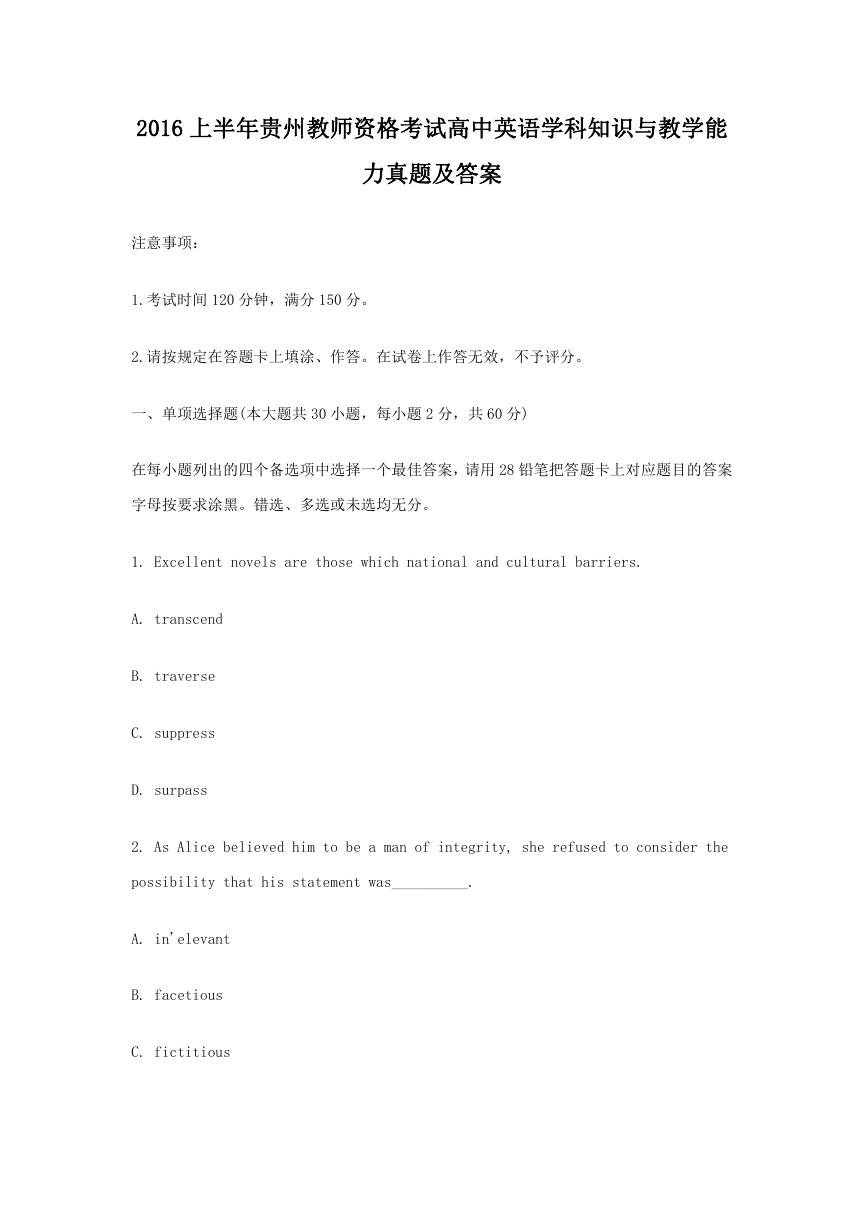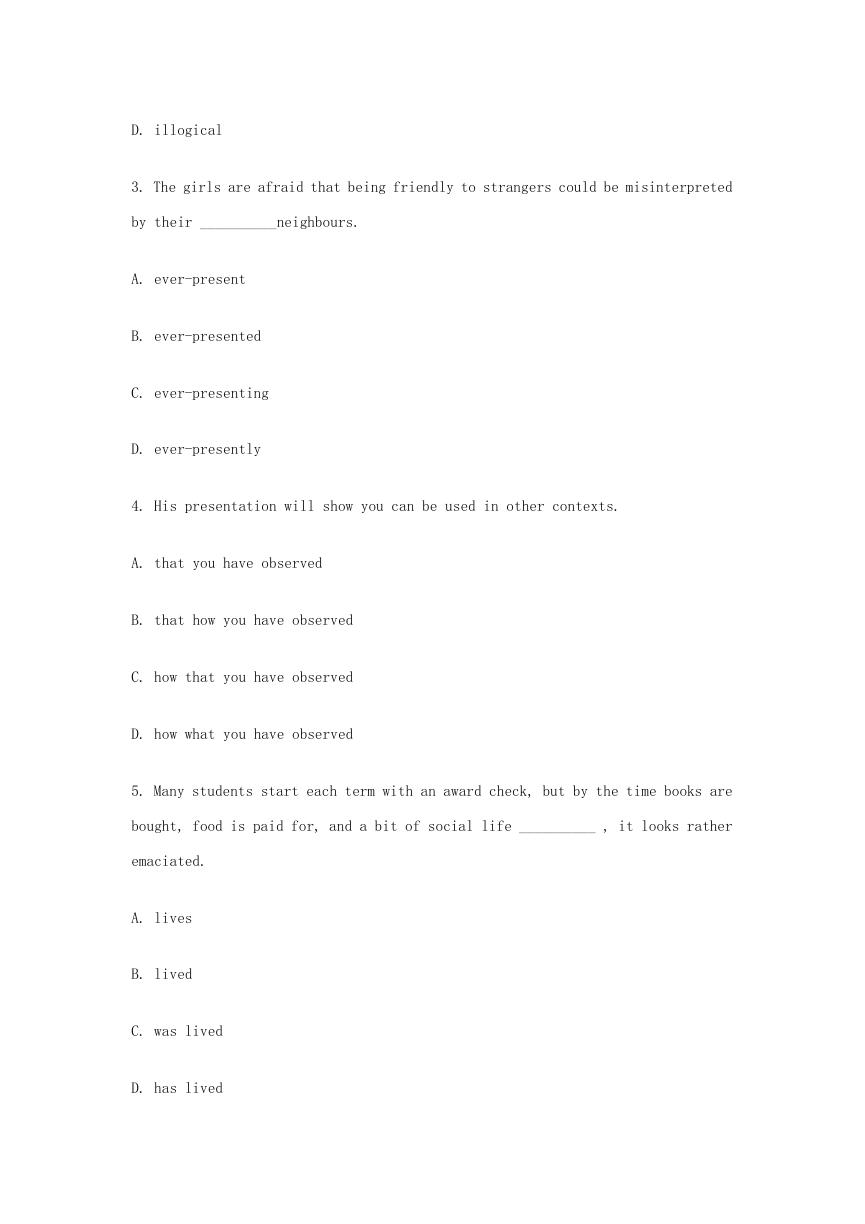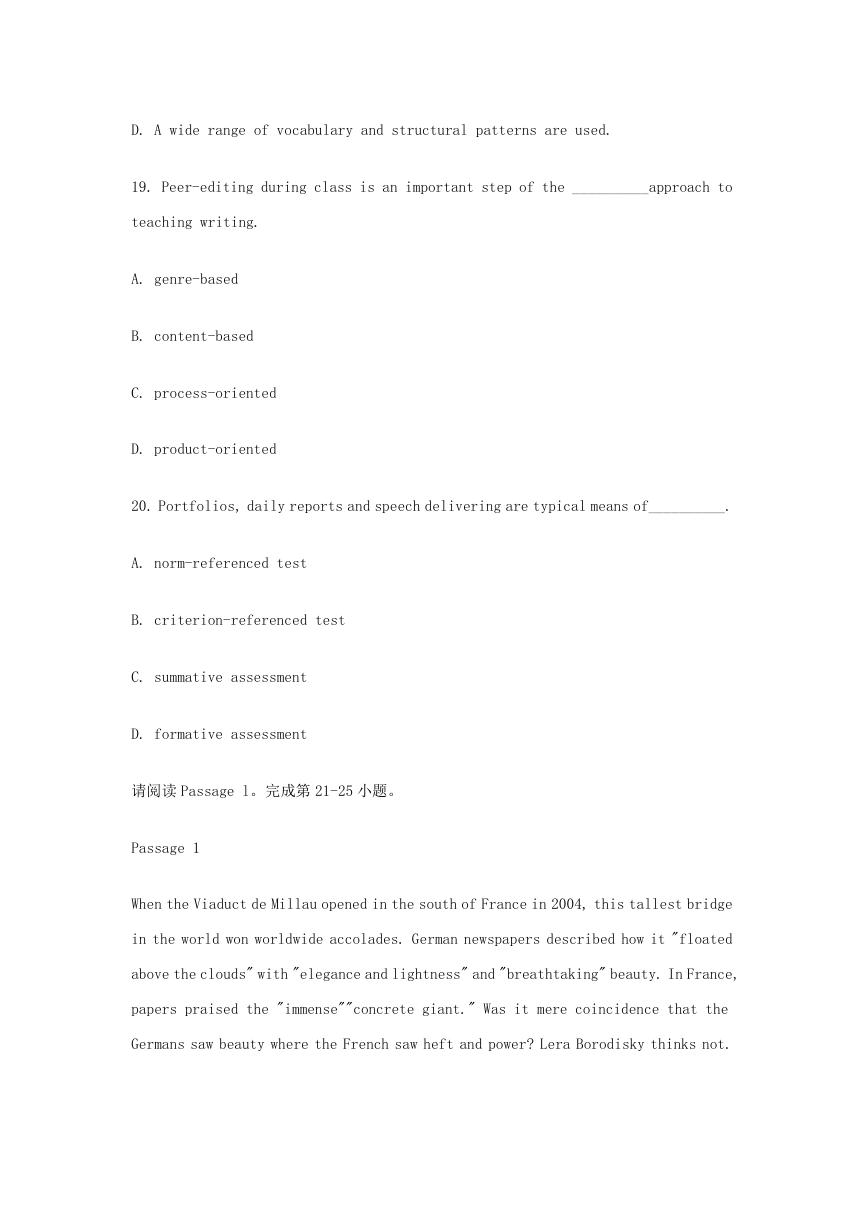2016 上半年贵州教师资格考试高中英语学科知识与教学能
力真题及答案
注意事项:
1.考试时间 120 分钟,满分 150 分。
2.请按规定在答题卡上填涂、作答。在试卷上作答无效,不予评分。
一、单项选择题(本大题共 30 小题,每小题 2 分,共 60 分)
在每小题列出的四个备选项中选择一个最佳答案,请用 28 铅笔把答题卡上对应题目的答案
字母按要求涂黑。错选、多选或未选均无分。
1. Excellent novels are those which national and cultural barriers.
A. transcend
B. traverse
C. suppress
D. surpass
2. As Alice believed him to be a man of integrity, she refused to consider the
possibility that his statement was__________.
A. in'elevant
B. facetious
C. fictitious
�
D. illogical
3. The girls are afraid that being friendly to strangers could be misinterpreted
by their __________neighbours.
A. ever-present
B. ever-presented
C. ever-presenting
D. ever-presently
4. His presentation will show you can be used in other contexts.
A. that you have observed
B. that how you have observed
C. how that you have observed
D. how what you have observed
5. Many students start each term with an award check, but by the time books are
bought, food is paid for, and a bit of social life __________ , it looks rather
emaciated.
A. lives
B. lived
C. was lived
D. has lived
�
6. Which of the following is correct in its use of punctuation?
A. The teacher asked, "Who said, ' Give me liberty or give me death' ?"
B. The teacher asked, "Who said, 'Give me liberty or give me death?'"
C. The teacher asked, "Who said 'Give me liberty or give me death'"?
D. The teacher asked, "Who said 'Give me liberty or give me death'?"
7. The pair of English phonemes, __________ differ in the place of articulation.
A./ ʃ/and/ʒ/
B. /θ/ and /e/
C. /d/ and /z/
D. /m/ and /n/
8. There are __________consonant clusters in the sentence "Brian, I appreciate
beautiful scarf you brought me."
A. two
B. three
C. four
D. five
9. When saying "It' s noisy outside" to get someone to close the window, the speaker
intends to perform a(n) __________.
�
A. direct speech act
B. locutionary act
C. indirect speech act
D. perlocutionary act
10. That a Japanese child adopted at birth by an American couple will grow up speaking
English indicates __________ of human language.
A. duality
B. cultural transmission
C. arbitrariness
D. cognitive creativity
11. Fluent and appropriate language use requires knowledge of__________ and this
suggests that we should teach lexical chunks rather than single words.
A. denotation
B. connotation
C. morphology
D. collocation
12. "Underlining all the past form verbs in the dialogue" is a typical exercise
focusing on__________.
A. use
�
B. form
C. meaning
D. function
13. Which of the following activities may be more appropriate to help students
practice a new structure immediately after presentation in class?
A. Role play.
B. Group discussion.
C. Pattern drill.
D. Written homework.
14. When teaching students how to give appropriate responses to a congratulation
or an apology, the teacher is probably teaching at__________.
A. lexical level
B. sentence level
C. grammatical level
D. discourse level
15. Which of the following activities can help develop the skill of listening for
gist?
A. Listen and find out where Jim lives.
B. Listen and decide on the best title for the passage.
�
C. Listen and underline the words the speaker stresses.
D. Listen to pairs of words and tell if they are the same.
16. When an EFL teacher asks his student "How do you know that the author liked
the place since he did not tell us explicitly?", he/she is helping students to reach
__________ comprehension.
A. literal
B. appreciative
C. inferential
D. evaluative
17. Which of the following types of questions are mostly used for checking literal
comprehension of the test?
A. Display questions.
B. Rhetorical questions.
C. Evaluation questions.
D. Referential questions.
18. Which of the following is a typical feature of informal writing?
A. A well-organized structure is preferred.
B. Short and incomplete sentences are common.
C. Technical terms and definitions are required.
�
D. A wide range of vocabulary and structural patterns are used.
19. Peer-editing during class is an important step of the __________approach to
teaching writing.
A. genre-based
B. content-based
C. process-oriented
D. product-oriented
20. Portfolios, daily reports and speech delivering are typical means of__________.
A. norm-referenced test
B. criterion-referenced test
C. summative assessment
D. formative assessment
请阅读 Passage l。完成第 21-25 小题。
Passage 1
When the Viaduct de Millau opened in the south of France in 2004, this tallest bridge
in the world won worldwide accolades. German newspapers described how it "floated
above the clouds" with "elegance and lightness" and "breathtaking" beauty. In France,
papers praised the "immense""concrete giant." Was it mere coincidence that the
Germans saw beauty where the French saw heft and power? Lera Borodisky thinks not.
�
In a series of clever experiments guided by pointed questions, Boroditsky is
amassing evidence that, yes, language shapes thought. The effect is powerful enough,
she says, that "the private mental lives of speakers of different languages may
differ dramatically," not only when they are thinking in order to speak, "but in
all manner of cognitive tasks," including basic sensory perception. "Even a small
fluke of grammar"--the gender of nouns--"can have an effect on how people think
about things in the world," she says.
As in that bridge, in German, the noun for bridge, Brucke, is feminine. In French,
pont is masculine. German speakers saw prototypically female features; French
speakers, masculine ones.
Similarly, Germans describe keys (Schlussel) with words such as hard, heavy, jagged,
and metal, while to Spaniards keys (llaves) are golden, intricate, little, and
lovely. Guess which language construes key as masculine and which as feminine?
Grammatical gender also shapes how we construe abstractions.
In 85 percent of artistic depictions of death and victory, for instance, the idea
is represented by a man if the noun is masculine and a woman if it is feminine,
says Boroditsky. Germans tend to paint death as male, and Russians tend to paint
it as female.
Language even shapes what we see. People have a better memory for colors if different
shades have distinct names--not English's light blue and dark blue, for instance,
but Russian's goluboy and sinly. Skeptics of the language-shapes-thought claim have
argued that that's a trivial finding,showing only that people remember what they
saw in both a visual form and a verbal one, but not proving that they actually see
the hues differently. In an ingenious experiment, however, Boroditsky and
colleagues showed volunteers three color swatches and asked them which of the bottom
two was the same as the top one. Native Russian speakers were faster than English
�
















 2023年江西萍乡中考道德与法治真题及答案.doc
2023年江西萍乡中考道德与法治真题及答案.doc 2012年重庆南川中考生物真题及答案.doc
2012年重庆南川中考生物真题及答案.doc 2013年江西师范大学地理学综合及文艺理论基础考研真题.doc
2013年江西师范大学地理学综合及文艺理论基础考研真题.doc 2020年四川甘孜小升初语文真题及答案I卷.doc
2020年四川甘孜小升初语文真题及答案I卷.doc 2020年注册岩土工程师专业基础考试真题及答案.doc
2020年注册岩土工程师专业基础考试真题及答案.doc 2023-2024学年福建省厦门市九年级上学期数学月考试题及答案.doc
2023-2024学年福建省厦门市九年级上学期数学月考试题及答案.doc 2021-2022学年辽宁省沈阳市大东区九年级上学期语文期末试题及答案.doc
2021-2022学年辽宁省沈阳市大东区九年级上学期语文期末试题及答案.doc 2022-2023学年北京东城区初三第一学期物理期末试卷及答案.doc
2022-2023学年北京东城区初三第一学期物理期末试卷及答案.doc 2018上半年江西教师资格初中地理学科知识与教学能力真题及答案.doc
2018上半年江西教师资格初中地理学科知识与教学能力真题及答案.doc 2012年河北国家公务员申论考试真题及答案-省级.doc
2012年河北国家公务员申论考试真题及答案-省级.doc 2020-2021学年江苏省扬州市江都区邵樊片九年级上学期数学第一次质量检测试题及答案.doc
2020-2021学年江苏省扬州市江都区邵樊片九年级上学期数学第一次质量检测试题及答案.doc 2022下半年黑龙江教师资格证中学综合素质真题及答案.doc
2022下半年黑龙江教师资格证中学综合素质真题及答案.doc